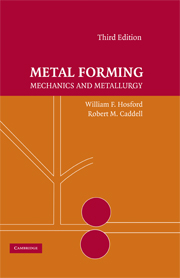Book contents
- Frontmatter
- Contents
- Preface to Third Edition
- 1 Stress and Strain
- 2 Plasticity
- 3 Strain Hardening
- 4 Instability
- 5 Temperature and Strain-Rate Dependence
- 6 Work Balance
- 7 Slab Analysis and Friction
- 8 Upper-Bound Analysis
- 9 Slip-Line Field Analysis
- 10 Deformation-Zone Geometry
- 11 Formability
- 12 Bending
- 13 Plastic Anisotropy
- 14 Cupping, Redrawing, and Ironing
- 15 Forming Limit Diagrams
- 16 Stamping
- 17 Other Sheet-Forming Operations
- 18 Formability Tests
- 19 Sheet Metal Properties
- Index
- References
14 - Cupping, Redrawing, and Ironing
Published online by Cambridge University Press: 05 June 2012
- Frontmatter
- Contents
- Preface to Third Edition
- 1 Stress and Strain
- 2 Plasticity
- 3 Strain Hardening
- 4 Instability
- 5 Temperature and Strain-Rate Dependence
- 6 Work Balance
- 7 Slab Analysis and Friction
- 8 Upper-Bound Analysis
- 9 Slip-Line Field Analysis
- 10 Deformation-Zone Geometry
- 11 Formability
- 12 Bending
- 13 Plastic Anisotropy
- 14 Cupping, Redrawing, and Ironing
- 15 Forming Limit Diagrams
- 16 Stamping
- 17 Other Sheet-Forming Operations
- 18 Formability Tests
- 19 Sheet Metal Properties
- Index
- References
Summary
Sheet forming differs from bulk forming in several respects. In sheet forming, tension predominates, whereas bulk forming operations are predominately compressive. In sheet forming operations at least one of the surfaces is free from contact with the tools. Useful formability is normally limited by localized necking rather than by fracture as in bulk forming. There are instances of failure by fracture but these are unusual.
Sheet forming processes may be roughly classified by the state of stress. At one end of the spectrum is the deep drawing of flat-bottom cups. In this case, one of the principal stresses in the flange is tensile and the other is compressive. There is little thinning, but wrinkling is of concern. At the other end of the spectrum are processes, usually called stamping, in which both of the principal stresses are tensile. Thinning must occur. Rarely does the formability in sheet forming processes correlate well with the tensile ductility (either reduction in area or elongation at fracture).
CUP DRAWING
The deep drawing of flat-bottom cups is a relatively simple process. It is used to produce such items as cartridge cases, zinc dry cells, flashlights, aluminum and steel cans, and steel pressure vessels. The process is illustrated by Figure 14.1. There are two important regions: the flange, where most of the deformation occurs, and the wall, which must support the force necessary to cause the deformation in the flange.
- Type
- Chapter
- Information
- Metal FormingMechanics and Metallurgy, pp. 220 - 236Publisher: Cambridge University PressPrint publication year: 2007
References
- 1
- Cited by

